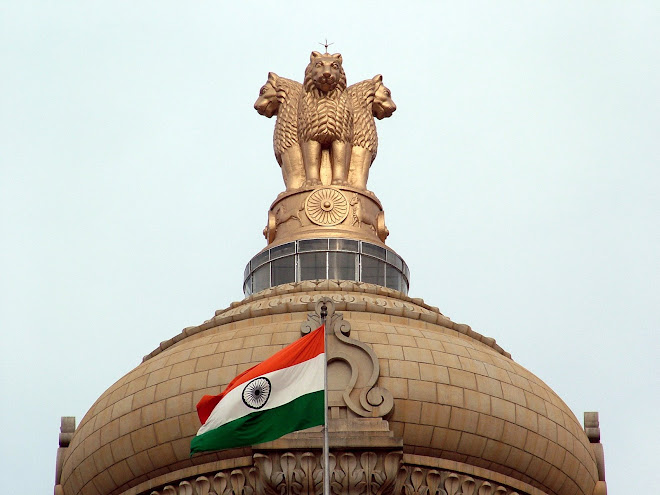 |
| Vinayak Damodar Savarkar was one of the most dynamic, outspoken and revolutionary leaders of the freedom struggle. Born on May 28, 1883 into a family of 'jagirdars '(landlords) in the village of Bhagpur near Nasik. Vinayak was one of four children. His elder brother Ganesh (Babarao) was to have a strong influence in his life. |
| Vinayak lost his parents at a very young age. The burden of the family fell on elder brother Babarao's shoulders. Vinayak spent his youth in fighting against the British Raj. As an extremely brilliant, outspoken and confident school boy, he was famous amongst his teachers and friends. In 1898 when Chaphekar brothers were hanged for assassinating the British Officer - Mr. Rand, Savarkar was just 15 years old. But Chaphekar's martyrdom impressed him and he decided to devote all his efforts for India's freedom. His patriotic spirit found an outlet when he formed an organization called the 'Mitra Mela'. He encouraged the young, patriotic members of the Mela to strive for "absolute political independence for India" by whatever means necessary. The Mitra Mela also played an important role in Nasik during the plague by serving the victims. |
| After matriculation in 1901, Savarkar took admission in Fergusson College of Poona and very soon dominated campus life. He, along with a group of students began dressing alike and using swadeshi goods only. He renamed the "Mitra Mela" as "Abhinav Bharat" and declared "India must be independent". In 1905, Savarkar and his friends expressed their resentment on the partition of Bengal by lighting a huge bonfire of foreign goods. |
| His instigating patriotic speeches and activities incensed the British Government. As a result the British Government withdrew his B.A. degree. In June 1906 he left for London to become Barrister. However, once in London, he united and inflamed the Indian students in England against British. He believed and advocated the use of arms to free India from the British and created a network of Indians in England, equipped with weapons. |
| The British government arrested Savarkar in London on 13 March 1910 on some fabricated charges and he was sent to India for trial. However as the ship in which he was being taken neared Marseilles in France, Savarkar escaped and swam to the port. According to the plan his friends were to be there beforehand, but they reached late and he was caught by the French Police. |
| Savarkar was declared guilty and was sentenced to 50 years of 'Kala Paani' in Andaman on 24 December 1910. Life for the prisoners was very harsh and the conditions inhuman. Since 4 July 1911, he was in Andaman Jail in solitude. Savarkar withdrew within himself, quietly and mechanically doing the tasks presented to him. He was successful in getting permission to start a jail library. With great effort and patience he taught the illiterate convicts to read and write. In 1920, Vithalbhai Patel demanded the release of the Savarkar brothers in the Central Legislative Assembly. Tilak and Gandhi also appealed for the release of Savarkar. On May 2, 1921, Savarkar was brought back to India. |
| Savarkar remained imprisoned in Ratnagiri Jail and then in Yeravada Jail until January 6, 1924 when he was freed under the condition that he would not leave Ratnagiri district and abstain from political activity for the next five years. On his release, Savarkar founded the Ratnagiri Hindu Sabha on January 23, 1924 that aimed to preserve India's ancient culture and work for social welfare. |
| Later Savarkar joined Tilak's Swaraj Party and founded the Hindu Mahasabha as a separate political party. He was elected President of the Mahasabha and toiled for building Hindu Nationalism and later joined the Quit India movement. |
| Savarkar was not only a fervent freedom fighter but he was also a good orator, prolific writer, a poet, a historian, a philosopher, and a social worker. His contribution to Marathi literature is immense. |
| Savarkar breathed his last at the age of 83. He passed away on February 26, 1966. |
Saturday, June 21, 2008
'Veer' Savarkar
'Lok Nayak' Jayaprakash Narayan
 | |||||||||
| Lok Nayak Jayaprakash Narayan, or JP, as he was fondly called by his followers was born on October 11, 1902, in Sitabdiara, a village on the border of Uttar Pradesh and Bihar, where the rivers Ganges and Sarayu meet. His father Harsudayal worked in the canal department of the State government and was often touring the region. There was no high school in the village, so Jayaprakash was sent to Patna to study in the Collegiate School. | |||||||||
| In Patna, he stayed with relatives at a hostel called Saraswati Bhavan, which was a meeting place for students who would normally discuss the political scene. Nationalism was at its highest and the people had woken up to the call of fearless leaders like Bal Gangadhar Tilak and Aravinda Ghose. Young Jayaprakash became inspired by their speeches. | |||||||||
| Jayaprakash was also fond of reading and excelled in his studies. He joined the Patna College on a Government scholarship. The Non-cooperation movement launched by Gandhiji in 1919 was gaining momentum. Jayaprakash too became involved and was inspired when he listened to Maulana Abul Kalam Azad speech. Maulana was a great orator and his call to give up English education had a deep impact on Jayaprakash and he left Patna College with just 20 days remaining for his examinations. He joined the Bihar Vidyapeeth, a college run by the Congress. The movement was withdrawn after it turned violent at Chauri Chaura in UP. The disappointed students returned to college. The Vidyapeeth had no more courses to offer. So Jayaprakash decided to go to America to pursue his studies. Meanwhile Prabhavati remained at Sabarmati in Gandhi's ashram.
|
Emperor Ashoka
 The great Indian emperor, Ashoka, was born in 265 B.C. He was the grandson of Changragupta Maurya and he ruled over an empire that covered two-thirds of the Indian continent. He was the most famous of the Mauryan kings and was one of the greatest rulers of India.
The great Indian emperor, Ashoka, was born in 265 B.C. He was the grandson of Changragupta Maurya and he ruled over an empire that covered two-thirds of the Indian continent. He was the most famous of the Mauryan kings and was one of the greatest rulers of India.The capital of the empire was in the city of Pataliputra (modern day Patna) , where Buddha had lived.
Emperor Ashoka was very courageous and a good administrator. Though he was the younger son of the king he was given the throne after the kings death because he was loved and respected by his subjects and by his ministers. In 268 B.C., Ashoka was crowned the king of Magadha.
8 Years after being crowned the king, Ashoka decided to annex Kalinga(Orissa) into his kingdom. This was the first and last battle that Ashoka ever fought. Though Ashoka won the battle he was horrified by the loss of life and death of so many soldiers.
his experience changed him and he swore that he would never wage war again. He took-up Buddhism, and he vowed to practice only virtuous actions in the future. After instructions by members of the Buddhist community, Ashoka began to resemble the ideal leader, promoting prosperity and peace within society. He religiously followed the principles of Buddhism - that of truth, charity, kindness, purity and goodness.
| Ashoka also asked his followers to take the path of virtuous action. He believed in non-violence and banned the sacrifice of animals. Besides this he opened clinics for birds and animals too. His good works earned him the name of Devanamapriya Priyadarshi. He also propagated Buddhism by engraving it's principles on pillars throughout his kingdom. The Ashoka pillars, as they are now called, were over 40 feet high and extremely heavy. He also attempted to spread this religion to Syria, Egypt and Macedonia, and sent his son Mahendra and daughter Sangamitra to Sri Lanka for this purpose. | |
| Ashoka died in 232 BC and is amongst the greatest rulers in the history of the Indian Subcontinent and he is respected for being the 'Ideal' ruler. |
Sardar Vallabhbhai Patel the 'Man of Steel'
 | Sardar Vallabhbhai Patel was born in Gujarat on 31st of October 1875 into a family of patriots. His father was a farmer and fought for India's freedom from the British. Vithalbhai, Vallabhbhai's elder brother, was also a well-known patriot. He was the Chairman of the Indian Legislative Council. From a young age itself Vallabhbhai was very courageous and raised his voice against injustice. His ambition was to become a barrister like his brother. He studied very hard and travelled to England and passed the Barrister-at-Law Examination. After he returned to India he setup a practice in Ahmedabad which was very successful and he earned a lot of money. Around this time the struggle for freedom was gaining a lot of momentum. Gandhiji attended a conference in Gujarat where he met Vallabhbhai and they became friends. | ||
| |||
| In 1942 Sardar Vallabhbhai Patel was again sent to jail because of the start of the "Quit India Movement". | |||
| 1n 1947 when India got freedom Sardar Patel became the Deputy Prime Minister. He was in charge of Home Affairs, Information and Broadcasting and the Ministry of States. He was given the task of organizing 600 states into one nation. He took strong steps like sending the army to Junagadh and Hyderabad to force them to align with free India. It is because of these strong steps that earned him the title of "The man of steel". | |||
| Sardar Vallabhbhai passed away in Bombay on the morning of the 15th December 1950. | |||
Rana Pratap
| Rajput (from Raj-Putra i.e. prince or literally "king's son") | |
 | The Rajputs are a brave and a chivalrous race who were feudal kings in ancient India before the Mughals came. They were the first to resist the Mughal invaders and many wars were fought between the Rajputs and the Mughals. Though the Mughals captured the north of India they were unsuccessful in capturing central India where they faced tough opposition from the Rajput kings there. Akbar wanted to control the whole of India and used a mix of tolerance, generosity, and force to over come the Rajput kings. One of the most gallant Rajput kings was Rana Pratap who did not want to give up his kingdom to the Mughals. |
| Rana Pratap was the Grandson of Raja Udai Singh (Udaipur is named after him), the king of Chittod. Rana Pratap led the Rajputs against the army of Akbar to preserve the independence of Mewar. Rana Pratap not only had to face the mighty Mughals but also had to fight against other Rajput kings(Raja Todar Mal and Raja Man Singh ) who aligned with the Mughals. In the Battle of Haldighati(1576) fought between Maharana Pratap and the Mughals; the Rajputs were not able to overcome the combined strength of the Mughals and the renegade Rajput princes who had played the role of traitors. Maharana Pratap was badly hurt in the battle and was saved by his wise horse Chetak, who took him in an unconscious state away from the battle scene. Rana Pratap died in 1597 when his son Amar Singh took over the kingdom. Although Maharana Pratap was not able to thwart the Muslims successfully, the saga of Rajput resistance to Muslim rule continued till the 17th century when the baton of the struggle for Indian Independence from Mughals was taken up by the upcoming power of the Marathas, who brought about an end to Muslim domination of India. | |
Bhagat Singh

Bhagat Singh grew up at a time when the Freedom struggle was all around him. Since his young age he wondered why so many Indians could not get freedom from a few British invaders, he dreamed of a free India. The massacre at Jallianwala Bagh on April 13, 1919 drove him to go to Amritsar, where he kissed the earth and brought back home a little of the blood soaked soil, he was just 12 years old then. Kartar Sing Sarabha, hanged at the age of 19 by the British was Bhagat Singh's hero.
| Bhagat Singh, along with the help of Chandrashekhar Azad, formed the Hindustan Socialist Republican Army (HSRA). The aim of this Indian revolutionary movement was defined as not only to make India independent, but also to create "a socialist India." | |
| In February 1928, a committee from England visited India. It came to be known as the Simon Commission. The purpose of its visit was to decide how much freedom and responsibility could be given to the people of India. Indian freedom fighters started an agitation called "Simon go back". It was in this agitation that during a police lathicharge, Lala Lajpat Rai was hurt and died. To avenge the death of Lala Lajpat rai, Bhagat Singh and Rajguru shot and killed the British Officer who had hit Lala Lajpat Rai. | |
| In April 1929, the Central Legislative Assembly met in Delhi. The British Government wanted to place before the Assembly two bills which were likely to harm the country's interests. Even if the Assembly rejected them, the Viceroy could use his special powers and approve them, and they would become laws. Bhagat Singh and Batukeshwar Dutt planned to throw a bomb in the Legislative Assembly and, get arrested. On 8th of April 1929 this is what they exactly did. The idea of the attack was not to kill anyone but to create awareness about India's freedom struggle. They were arrested after this attack. | |
| In their trial Bhagat Singh and Batukeshwar Dutt stated, "If the deaf are to hear, the sound has to be very loud. When we dropped the bomb, it was not our intention to kill anybody. We have bombed the British Government. The British must quit India and make her free." In the trial it was decided that Bhagat Singh, Sukhdev and Rajguru were to be hanged for all their anti British activities. On 24th of March 1931 Bhagat Singh walked upto the hanging rope kissed it and put it around his neck to be hanged. | |
| Bhagat Singh became "Shaheed Bhagat Singh" or Martyr at the age of 24. The stories of his courage and patriotism became an inspiration for many youth at that time who wanted to see India independent. Even today Shaheed Bhagat Singh's memory continues to inspire the youth and many poems and songs have been written about his courage and undying patriotism. |
Lala Lajpat Rai
 Lala Lajpat Rai was born on 28th Jan, 1865 in a village named Dhudike in Ferozepur District of Punjab. His father, Munshi Radha Krishan Azad was a teacher and scholar of Persian and Urdu and his mother Shrimati Gulab Devi was a deeply religious lady. |
| After schooling, Lalaji joined the Government College at Lahore in 1880 to study Law. During this time the Arya Samaj movement was gaining momentum and Lalaji joined it. Lalaji passed his Mukhtiarship (junior pleader) examination and started his legal practice in Jagraon. He passed his Law exams from Government College in 1885. |
| Lalaji started his legal practice in Rohtak but later moved it to Hissar. His practice in Hissar flourished. Lalaji remained an active member of the Arya Samaj, collecting funds for the Daya Nand College. He was also elected to the Hissar municipality as a member and later as secretary. After the death of Swami Dayananda, Lalaji, with his associates toiled to develop the Anglo-Vedic College. He came in contact with all the important Arya Samajis there. |
| By now Lajpat Rai had curtailed his legal practice and was concentrating all his efforts to serve the nation and its people. His activities were multifarious. He was an ardent social reformer. He founded the Indian Home Rule League of America in October 1917, in New York and, a year later, he also set up, with himself as Director, the "Indian Information Bureau" to serve as a Publicity Organization for India. Lala Lajpat Rai returned to India on Feb.20, 1920 as a great hero. |
| Lalaji was invited to preside over the special session of the Congress in Calcutta in 1920. He plunged into the non-cooperation movement, which was being launched in response to the Rowlatt (Black) Act, in principle. The movement spread like fire in Punjab under Lajpat Rai's leadership and he soon came to be known as "The Lion of Punjab" or "Punjab Kesri". He travelled far and wide in India and his dynamism injected new life in his countrymen. His speeches were hard hitting and full of passion and influenced many. |
| Lala Lajpat Rai's supreme sacrifice came when he led a procession in Lahore on Oct.30, 1928 to boycott the all British Simon Commission. The procession was meant to be a peaceful protest, but the police resorted to 'lathi-charged'. While Lalaji tried his level best to keep the demonstration peaceful, the police targeted him and wounded him on his chest. The people were enraged at this insult and held a meeting the same evening. Lalaji, even though injured, delivered a fiery speech and declared "...every blow aimed at me is a nail in the coffin of British Imperialism....". |
| He recovered from the wounds left by the British but he remained emotionally scarred at the brutality of the "civilized" British. These thoughts racked his spirit till the very end. Lalaji passed away on November 17, 1928 of heart failure. |
Sarojini Naidu
 | ||||||||||||||||||||||
| | ||||||||||||||||||||||
| Sarojini Naidu was one of the most prominent leaders of India's freedom struggle. Born on February 13, 1879 in Hyderabad, Sarojini was the eldest daughter of Varasundari and Dr. Aghornath Chattopadhyaya, who was a scientist and founder-principal of Nizam College of Hyderabad. Her mother Varasundari was a Bengali poetess. | ||||||||||||||||||||||
| Sarojini's father aspired for her to become a mathematician or scientist, but young Sarojini was drawn towards poetry from a very early age. Seeing her flair for poetry, her father decided to encourage her. With her father's support, she wrote the play "Maher Muneer" in the Persian language. Dr. Chattopadhyaya sent a copy to the Nawab of Hyderabad who was very impressed by the beautiful play written by her. Sarojini got a scholarship to study abroad and got admitted to King's College, London and then later at Girton College, Cambridge. | ||||||||||||||||||||||
| Sarojini met Dr. Govind Naidu, during her stay in England and later married him at a time when inter-caste marriages were not allowed. Soon after, she met Shree Gopal Krishna Gokhale and Gandhi and was influenced by them. Sarojini was now whole-heartedly working for India's freedom movement. Her poems poured enthusiasm and hope in the hearts of the masses as they became united in the struggle for freedom. Naidu also travelled across India and campaigned for the rights of women. She was responsible for establishing self-esteem in Indian women. In 1925, Sarojini became the first Indian woman president of the National Congress--having been preceded eight years earlier by the English feminist Annie Besant. She travelled far and wide, to places like South Africa and North America, lecturing on the Congress movement. She accompanied Gandhi to London for the inconclusive second session of the Round Table Conference for Indian-British cooperation (1931). Back in India her anti-British activities brought her a number of prison sentences (1930, 1932, and 1942-43).
|
Subhash Chandra Bose-Freedom Fighter

Subhash Chandra Bose was born on January 23, 1897 at Cuttack, in Orissa. He was the sixth son of Janakinath and Prabhavati Bose.
Subhash was an excellent student and after school joined the Presidency College, Calcutta, where he studied philosophy, a subject he was interest in.
As a young boy Subhash felt neglected among his 8 siblings. At his English school he suffered under the discrimination faced by Indians which made him even sadder.
He wanted to work for the poor but his father, had other ideas. He sent Subhash to England to appear for the Indian Civil Service. In July 1920, barely eight months later Subhash Chandra Bose appeared in the Civil Service Examination and passed it with distinction. But he didn't want to be a member of the bureaucracy and resigned from the service and returned to India.
Back home, he participated in the freedom movement along with 'Deshbandhu' C.R. Das. He was thrown into jail but that only made him more determined. Subhash joined the congress and rose to its Presidentship in 1938 a post he held for 2 years.
In 1939, when the Second World War started Gandhiji and other leaders were against doing anything anti-Britain. But Subhash thought differently. He knew, for instance, that the fall of the Roman Empire had led to the freedom of its colonies. He decided to seek foreign help for his cause of freeing India.
He was arrested and kept in his house under detention. On January 17, 1941, while everyone was asleep, Bose slipped out of his house into a waiting car. Disguised as a Muslim religious teacher, Bose managed to reach Peshawar two days later.
Bose went to Italy, Germany and even Russia to seek help but without much use. Subash decided to organize Indians on his own. He landed in Singapore and grouped Indians there into the Indian National Army or the Azad Hind Fauj and declared himself the temporary leader of the free Indian government. Japan, Germany and Italy recognizied Subhash's government and the whole of India rejoiced.
| The INA marched to Andaman and Nicobar islands, liberating and renaming them as Shaheed and Swaraj islands. On March 18, 1944, it crossed the Burmese border and reached Manipur where free India's banner was raised with the shouts of 'Jai Hind' and 'Netaji Zindabad'. But heavy rain prevented any further movement and the units had to fall back. Even then Netaji was determined. On August 17, 1945, he issued a Special Order to the INA which said that "Delhi is still our goal". | |
| He then wanted to go to Russia to seek Soviet help to fight the British. But the ill-fated plane in which he was flying, crashed in Taipei on August 18, 1945, resulting in his death. | |
| Some people believe that Subhash Chandra Bose didn't die, that he faked his own crash to escape the British who wanted to arrest him. There were even reports of Bose living in Russia and other foreign countries, even some claims of having seen him as a sadhu� but none were ever proved and today his death in the plane crash is the accepted version. |
KALIDASA-Writer, Poet, Dramatist
Kalidasa, one of the chief figures in classic Sanskrit literature was also a dramatist and poet. He was one of the Navratnas (9 gems or the most accomplished men of their times) at the court of Chandragupta Vikramaditya. Kalidasa's works include plays, Epics and lyrics. His play 'Abhinjnana Sakunthalam' (Recognition of Sakunthala) is the most well-known of all his works and it has been translated into various languages of the world. In all, 7 works of Kalidasa are available today. They are: 'Malavikagnimitra', 'Vikramorvasiyam' and 'Abhijnana Sakunthalam' (plays); 'Raghu Vansa' and 'Kumara Sambhavam' (Epics); 'Meghdoot' and 'Ritu Samhara' (lyrics).
He was one of the Navratnas (9 gems or the most accomplished men of their times) at the court of Chandragupta Vikramaditya. Kalidasa's works include plays, Epics and lyrics. His play 'Abhinjnana Sakunthalam' (Recognition of Sakunthala) is the most well-known of all his works and it has been translated into various languages of the world. In all, 7 works of Kalidasa are available today. They are: 'Malavikagnimitra', 'Vikramorvasiyam' and 'Abhijnana Sakunthalam' (plays); 'Raghu Vansa' and 'Kumara Sambhavam' (Epics); 'Meghdoot' and 'Ritu Samhara' (lyrics).
As far as literacy merits are concerned, Meghdoot (cloud messenger) is the most excellent work.
Wednesday, June 18, 2008
AISHWARYA RAI-Model, Miss World, Actress
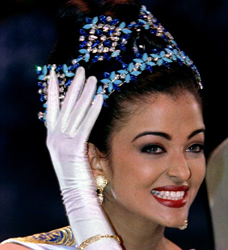
Born to parents Krishna Raj and Vrinda Rai, she and her brother Aditya, were brought up in a middle class background. Aishwarya did her schooling at Arya Vidya Mandir, Santacruz in Mumbai and junior college from Jai Hind. She pursued her graduation in Architecture from Rachana Sansad School, Mumbai. By this time, Aishwarya started getting modelling assignments in Fashion shows and advertisemnet campaigns. She won the Famous Ford Supermodels Contest at the age of 17. From that point there was no looking back. She participated in the Miss India Femina contest 1994 and became the Ist runner up which paved her way for winning the Miss world crown 1994. Aishwarya Rai's career took off as soon as she became 1994 Miss World.
She made her debut into films with Mani Rathnam's ' Iruvar' in which she did her part wonderfully, but it was 'Hum Dil De Chuke Sanam' that made her popular as an actress. She has acted in several films like 'Taal', 'Josh', 'Khakee', 'Mohabbattein', and has won the Filmfare Awards for the Best Actress category for 'Hum Dil De Chuke Sanam'. Hum Dil De Chuke Sanam not only gave her the real breakthrough but also proved her mettle as an actress
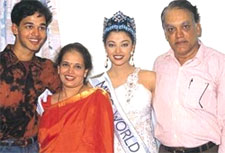 Aiswarya Rai reteamed with Sajay Leela Bhansali in 'Devdas' which was released world wide and received a special screening at the Cannes Film Festival. The Bengali film 'Choker Bali', adapted from Rabindranath Tagore's novel 'Binodini' fetched her critics acclaim.
Aiswarya Rai reteamed with Sajay Leela Bhansali in 'Devdas' which was released world wide and received a special screening at the Cannes Film Festival. The Bengali film 'Choker Bali', adapted from Rabindranath Tagore's novel 'Binodini' fetched her critics acclaim.
Aishwarya is the first Indian actress to be on the jury of the Cannes International Film Festival (2003). She was also featured on the cover of the Time magazine.
2004 saw Aishwarya take on the lead role in her first English language film for Gurinder Chadha in "Bride & Prejudice" (of "Bend It Like Beckham" fame) and Rituparna Ghosh's 'Raincoat'.
2005 started with appearances on "60 Minutes", "David Letterman Show" and the most watched television program in the world the "Oprah Winfrey Show". Aishwarya was seen in more Hollywood flicks like 'Mistress of Spices' by director Paul Berges, Jag Mundhra's 'Provoked', and legendary film producer Dino De Laurentiis's 'The Last Legion' opposite Colin Firth and Sir Ben Kingsley.
In 2006 she is back in Bollywood with movies like Sanjay Gadhvis' 'Dhoom-2', JP Dutta's 'Umrao Jann', Mani Ratnam's 'Guru', and Ashutosh Gowariker's 'Jodha- Akbar', in which she plays the title role of Mughal king Emperor Akbar's Hindu wife and queen.
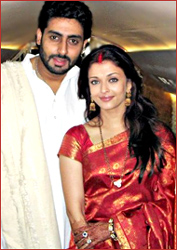 Aishwarya’s life has been eclipsed by an unhappy affair with bollywood star Salman Khan. After years of speculation she declared that she would never work with him again for personal reasons. She was also linked to Bollywood actor Vivek Oberoi and now it is said that, she is dating Abhishek Bachchan and was frequently seen in public with him and his family, fueling rumors of an engagement. After much gossips concerning their relationship, her engagement to Indian actor Abhishek Bachchan was announced on January 14, 2007. The event was heavily covered by the media. And finally they got married on April 20, 2007 in a private ceremony held at the Bachchans' bungalow Prateeksha.
Aishwarya’s life has been eclipsed by an unhappy affair with bollywood star Salman Khan. After years of speculation she declared that she would never work with him again for personal reasons. She was also linked to Bollywood actor Vivek Oberoi and now it is said that, she is dating Abhishek Bachchan and was frequently seen in public with him and his family, fueling rumors of an engagement. After much gossips concerning their relationship, her engagement to Indian actor Abhishek Bachchan was announced on January 14, 2007. The event was heavily covered by the media. And finally they got married on April 20, 2007 in a private ceremony held at the Bachchans' bungalow Prateeksha.
On the personal front, Aishwarya campaigns for many social causes. She has generously volunteered to donate her eyes and has set an example for the rest of the world. Lovely Aishwarya Rai has proved her mettle in whatever she does especially in acting, and still remains one of the leading actresses in the tinsel world.
THYAGARAJA-Karnatic Music
Tyagaraja is one of the most popular among the composers of Karnatic music. He was born on 4 May 1767 at Tiruvarur, Tamil Nadu. Tyagaraja was one of those precious gems who gave a new direction to Indian music. He was a profound scholar and poet and also known as 'Sangeet-Guru'.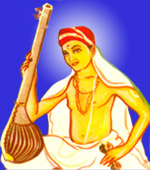 The music compositions, 'Tyagaraja Gana', 'Valmikiya Kavana' and 'Agumbeya Astamaya' are said to be unique for enrapturing the human heart.
The music compositions, 'Tyagaraja Gana', 'Valmikiya Kavana' and 'Agumbeya Astamaya' are said to be unique for enrapturing the human heart.
Thyagaraja composed devotional verses and set them to music. He popularised music in the form of Kirtans. His immortal 'Pancharatna Kritis' (the five gems) reveal the mastery of his genius. He was of the view that art cannot be weighed in money, nor can it be compensated by it. He composed 700 verses and set them to music in 500 different ragas.
Eighteenth and Nineteenth centuries are significant in the annals of Indian music because of Thyagaraja. His special sound effect which revolutionised Karnatic music distinguished Thyagaraja in the field of poetry. He also created two operas: 'Prahlada Bhakti Vijayam' and 'Nauka charitam'. Majority of his songs are in Telugu while a number of them are in Sanskrit.
Spiritually he was one of the rare souls who gave up everything and cared for nothing else beyond the grace of God. The only things that mattered to him was his music and faith. He was a great devotee of Lord Rama. Thyagaraja passed away on 6th January 1847.
M.S.SUBBALAKSHMI-Carnatic Singer

Young Kunchamma as she was called and her siblings was brought up in a musical environment in her home close to the Madurai Meenakshi Temple. Her grand mother Akkammal was a violinist. Her mother used to play and rehearse constantly and Kunchamma used to listen and hum ragas along with the Veena and the Nadaswaram recitals frequently heard from the temple. Her first Guru was Madurai Srinivasa Iyengar but her lessons could not last long as her guru passed away soon after she finished her foundations. But she kept practicing on her own for long hours. She did her formal schooling only till class 5th and music became the world for her. Subbalakshmi's perfect pitch whether high or low and fantastic range of voice is the result of her dedication, toil and hours of continuous practice. As a child, when she practiced she would stop playing the tambura in between to check whether she is maintaining the pitch with and without it. She also learned Hindustani music from Pandit Narayan Rao Vyas for a short while. In the 1930's she learned 'khayals' and 'thumris' from Dwijenderlal Roy in Calcutta and later from Siddheshwari Devi of Benares and bhajans and Rabindra Sangeet from Dilipkumar Roy, she incorporates bhajans in almost all her concerts.
Little Kunchamma accompanied her mother in local concerts and later gave solo 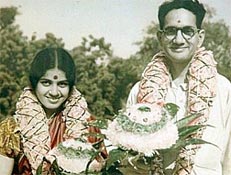 performances. She was the child prodigy of Madurai at one time. Her first recording was at the age of ten, when she recorded a couple of songs 'Marakat vadivu' and 'Oothukuzhiyinile' in an impossibly high pitch for HMV in Madras. In 1934, in her debut at the Madras Music Academy she was noticed and applauded by top rank musicians like Chembai Vaidyanatha Bhagavathar, Tiger Varadachariar, Karaikudi Sambavisa Iyer and the likes.
performances. She was the child prodigy of Madurai at one time. Her first recording was at the age of ten, when she recorded a couple of songs 'Marakat vadivu' and 'Oothukuzhiyinile' in an impossibly high pitch for HMV in Madras. In 1934, in her debut at the Madras Music Academy she was noticed and applauded by top rank musicians like Chembai Vaidyanatha Bhagavathar, Tiger Varadachariar, Karaikudi Sambavisa Iyer and the likes.
In 1940 she married Thiagaraja Sadasivam, a well known figure in the Madras Congress circle, at Thiruneermalai. They had met four years earlier and with his wide connections in the journalistic and political world, he became instrumental in the continued success of her already flourishing career. From 1938 for a period of six years she started acting in films for a short while. Her films were quite successful but later in 1944 after her big hit 'Meera' produced by her husband and released in Tamil and Hindi, she quit and concentrated solely on music. From a South Indian celebrity she went on to become a national figure. Internationally she has given concerts almost all over the world like at Edinburgh festival and at the United Nations(1970), Carnegie Hall as the inaugural concert of the festival of India in London in 1982.
Subbalakshmi has been the recipient of the highest awards and honours the nation could bestow upon an artist and significant international recognition. She has earned doctorates from famed universities and her divine voice has earned acclaim from big and famous personalities like Mahatma Gandhi, Pandit Jawarharlal Nehru, Maharana of Udaipur etc as well as top rank musicians both in the Carnatic and Hindustani sphere in the country. In 1998, she was the first musician to receive the highest civilian award 'Bharat Ratna' from the President of India. Padma Bhushan(1954), Padma Vibhushan(1975), Ramon Magsaysay award (1974) are some of the major awards she has received.
The world of fame and adoration of thousands of fans, has left Subbalakhsmi untouched. She remains the simple, neat, devout, down to earth person she always was and having a genuine interest in others. She passed away at the age of 88.Ilaiyaraja -Music Composer
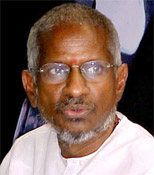
He was born as Gnanadesikan aka Rasaiya, the third son to parents Ramasamy and Chinnathayi on 2nd June 1943 in Pannaipuram, near Madurai, Tamil Nadu. Music was in his blood even from childhood and it was his brother Paavalar Varatharasan who encouraged this talent to its maturity.
Rasaiya and his brother had a music troupe and they conducted many programmes throughout Tamil Nadu during 1958 to 1968. In 1968, he came to Chennai to learn music. In 1970, he appeared for the examination of the Trinity college of Music, London in Classical Guitar and came out with a Gold Medal. Simultaneously he had his grounding in Indian classical music. During this early years in Chennai he also learned Western Music from Dhanraj Master. It was Dhanraj Master who re-christened him as Raja. After acquiring knowledge in Music, he tried his luck in the film industry and got an opening through the Tamil film director Panju Arunachalam for his film 'Anarkali' in 1976. Panju Arunachalam not only gave Raja the entry ticket to the tinsel world but also an exciting name- Ilaiyaraaja. From then on there was no looking back and Ilaiyaraaja went on to script a success story in South Indian Film music.
Since 1976, in a career spanning over 3 decades, he has completed over 840 films and composed over 5000 songs in various Indian languages like Tamil, Telugu, Malayalam, Kannada, Hindi and English . In the early 80's he used to produce music for at least 40 movies per year, some of them running 100 days just for the sake of the music alone. Raja has worked mostly with singers SP Balasubramaniam, S.Janaki, Chitra, Jesudas providing much of the music that defined their reputation.
His hits include songs from movies like 16 Vayathinilae, Sindhu Bhairavi, Anjali, Azhagi, Bharathi, Chinna Thambi, Dalapathi, Devar Magan, Guna, Hey Ram, Mouna Ragam (Tamil), Sadma, Lajja (Hindi), Olangal, Moonnam Pakkam, Kaalapaani, Achuvinte Amma, Kochu Kochu Santhoshangal (Malayalam) and many more...
Besides composing movie songs, he has many background tracks for movies and non-film albums including devotional and instrumental albums to his credit. Notable among them is Vedic Chants (a rendition of the Vedas by an eight year old girl), Gitanjali, Raajavin Ramana Maalai, Ilayarajavin geethavazhippaadu etc. He is highly spiritual and has composed many devotional songs on Ramana Maharshi, Saadhu Sri Raam Surat Kumar (Visiri Saamiyaar). He was one among the few composers who attempted unique styles in folksy tunes.
He had credited a truly unique orchestration technique, which involves blending of western and Indian instruments. He is the first Asian to compose a full symphony with the Royal Philharmonic Orchestra (RPO) of London under the baton of John Scott. He was hence called by the name 'Maestro' Ilayaraja.
Beside his career in film music he had written lyrics to fusion albums and as a part of his experimentation, he has tried blending western classical fusions with the traditional Indian music. The two famous fusion albums of his compositions are 'How to name it' and 'Nothing but wind'. The second album, 'Nothing but wind', features noted flutist Pandit Hariprasad Chaurasya. In this albums fusion has been explored and exposed in depth. His most recent work India 24 hours and Thiruvasakam in Symphony has added yet another feather to his cap. Thiruvasakam in Symphony an Oratorio of Thiruvasakam with Symphony orchestration.
He created a new raga by name 'Panchamukhi' of his own explaining the five facets of music. He is the only music director to compose a song in just 3 notes (swaras). During his on-stage Carnatic vocal performance, he sang his own 'Kirthanas'. Ilayaraja has also produced some movies under the banner Pavalar productions in remembrance of his brother.
Ilayaraja has received many awards for his contributions to the world of music. National Film award for Best Music direction three times for the films, Saagara Sangamam (Telugu 1984), Sindhu Bhairavi (Tamil1986) and Rudra Veena (Telugu 1989), Best Music Director award from the governments of Tamil Nadu, Kerala, Andhra Pradesh. 'Kalaimamani Award', an annual award for excellence in the field of arts, by the Government of Tamil Nadu (1988), Lata Mangeshkar Award for Excellence in Music from the Government of Madhya Pradesh(1998), Degree of Doctor of Letters by the Annamalai (1994) and Madurai Kamaraja University, Tamil Nadu (1996), Cultural Doctorate in Philosophy of Music by the World University Round Table, Arizona, U.S.A(1994) and many more. In 2002, his composition 'Rakkama Kaiya Thattu' from the movie Dhalapathi was the No.1 in BBC World Service Top Ten with more than 50% of the votes. He was the music composer for the Miss World 1996 Pageant, held at Bangalore.
Besides composing music, Raja loves photography and writing poetry. He is married to Jeeva and the couple have three children ( Sons Karthik Raja and Yuvan Shankar Raja and daughter Bhavtharini). Following the footsteps of their father, all of them are music composers and his daughter is also a play back singer. Raja's brother Gangai Amaran is also a composer and song writer.
LALGUDI JAYARAMAN-Violinist
Lalgudi Jayaraman, a legendary violinist in his own lifetime has gained the title with his spell binding technique and mastery over the instrument. In the sphere of Carnatic music, Sri 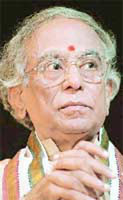 Lalgudi Jayaraman is a name that is instantly associated with musical excellence in melody, rhythm, style and technique.
Lalgudi Jayaraman is a name that is instantly associated with musical excellence in melody, rhythm, style and technique.
Born in the lineage of an illustrious disciple of the great saint musician Thyagaraja, Sri Lalgudi Jayaraman inherited the essence of Carnatic music from his versatile father late V R Gopala Iyer who trained him meticulously. At the early age of 12 he started his musical career as an accompanying violinist. Being endowed with rich imagination, quick grasp and an ability to adapt easily to the individual styles of the leading maestros in Carnatic music while accompanying them in their concerts , he reached the forefront in rapid strides. The rich concert experience he thus gained, coupled with sheer hard work and perseverance and the strong urge to give original expression to the musical ideas surging in him, he emerged as a solo violinist of rare brilliance.
He revolutionised the style of violin playing by inventing a whole new technique that is designed to best suit the needs of Indian Classical Music and establishing a unique style that came to be known as 'Lalgudi Bani'. His flawless and fascinating style, graceful and original, yet not divorced from traditional roots gained him numerous fans. This multi dimensional personality have to his creditcompositions, which are a scintillating blend of raga, bhava, rhythm and lyrical beauty. The unique feature about Lalgudi is that his music is very expressive. Lalgudi's instrumental genius comes to the fore in the form of lyrical excellence. composed several 'Krithis', 'thillanas' and 'varnams' and dance
He has been in great demand for accompanying vocalists, and has accompanied such great vocal virtuosos as Ariyakkudi Sri Ramanuja Iyengar, Semmangudi Sri Srinivasa Iyer, Sri G. N. Balasubramaniam, Alathur Brothers, Karaikkudi Sambasiva Iyer etc. His accompanying wizardry and lightning quick responses to the various challenges posed by the main artistes remain unsurpassed. His accomplishments are numerous but chief of them is the fact that he was the first to bring international attention to the Carnatic style of violin playing. He also introduced a new concept of musical ensemble with violin, venu (flute) and veena in 1966 and gave several outstanding concerts.
He has given concerts extensively in India as well as abroad. The Government of India sent him to Russia as a member of the Indian Cultural Delegation. At the Edinburgh Music Festival in 1965, Yehudi Menuhin, the renowned violinist, presented him with his Italian violin, impressed by Lalgudi's technique. He has also performed in Singapore, Malaysia, Manila and East European countries. His recordings submitted to the International Music Council, Baghdad, Asian Pacific Music Rostrum and Iraq Broadcasting Agency by AIR New Delhi have been adjudged as the best and accorded the first position out of 77 entries received from the various countries during 1979. He was invited to give concerts at Cologne, Belgium and France. The Government of India chose him to represent India at the Festival of India in USA , London and he gave solo and 'Jugalbandi' concerts in London and also in Germany and Italy that received rave reviews. Sri Lalgudi went on a tour in the year 1984 to Oman, UAE, Qatar and Bahrain that was highly successful. He composed the lyrics and music for the operatic ballet 'Jaya Jaya Devi' which premiered in 1994 at Cleveland, USA and was staged in many other cities in USA. In October 1999, Lalgudi performed in UK under the auspices of Shruthi Laya Seva Sangham. The concert was a roaring success. After the concert a Dance Drama 'Pancheswaram', composed by Lalgudi was staged.
The genius has earned several titles like 'Nada Vidya Tilaka' by Music Lovers’ Association of Lalgudi in 1963,
'Padmashree' by the Government of India in 1972, 'Nada Vidya Rathnakara' by East West Exchange in New York, 'Vadya Sangeetha Kalaratna' by Bharathi Society, New York; 'Sangeetha Choodamani' by Federation of Music Sabhas, Madras in 1971 and in 1972; State Vidwan of Tamil Nadu by the Government of Tamil Nadu and Sangeetha Natak Academy award in 1979 etc. The First Chowdaiah Memorial National-Level award was given to Sri Jayaraman by the Chief Minister of Karnataka. He has also received honorary citizenship of Maryland ,USA in 1994.
His son G. J. R. Krishnan and his daughter Lalgudi Vijayalakshmi follows the footsteps of their great father and are famous in their own rights.
USTAD ZAKIR HUSSAIN-Tabla Player
Zakir Hussain Alla Rakha Qureishi, one of the most accomplished Tabla player in the world was born in Mumbai on 9 March, 1951.The style and mastery over the Tabla seen in his brilliant performances have established him as a genius in the world of percussion both in India and abroad. This innovator has helped in bridging both the Hindustani and Carnatic traditions as well as the East and the West by performing with North and South Indian masters as well as with western musicians.
Zakir Hussain, son of renowned tabla maestro Ustad Alla Rakha, showed unusual talent on tabla drums as a child. He began his musical career at the age of seven and was touring by the age of twelve. At the age of 19, he accompanied the legendary sitar player, Pandit Ravi Shankar to the United States to perform at the Fillmore East. Three years later, he became the leader of the Tal Vadya Rhythm Band. The group subsequently evolved into the Diga Rhythm Band. In 1976, the band collaborated on a self-titled album with Mickey Hart of Grateful Dead. In 1975, Hussain joined with British guitarist John McLaughlin, Indian violinist L. Shankar and ghatam drummer Vikku Vinayakram to form the east-meets-west super group, 'Shakti'. Although the group disbanded in 1978, they reunited to tour as Remember Shakti in 1998. He founded Moment Records in 1992 which releases recordings and live concerts albums of great masters in Classical music.
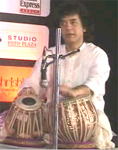 In 1987, Zakir's first solo release, 'Making music', was acclaimed as 'one of the most inspired East-West fusion albums ever recorded'. He has also composed and released many albums with the likes of George Harrison, Van Morrison, Joe Henderson etc and soundtracks of films like 'Apocalyse Now', 'In Custody', 'Little Buddha', 'Heat and Dust' etc for which he was nominated for the best music Director at the 1983 Cannes Film Festival. He arranged the opening music for the 1996 Summer Olympics in Atlanta.
In 1987, Zakir's first solo release, 'Making music', was acclaimed as 'one of the most inspired East-West fusion albums ever recorded'. He has also composed and released many albums with the likes of George Harrison, Van Morrison, Joe Henderson etc and soundtracks of films like 'Apocalyse Now', 'In Custody', 'Little Buddha', 'Heat and Dust' etc for which he was nominated for the best music Director at the 1983 Cannes Film Festival. He arranged the opening music for the 1996 Summer Olympics in Atlanta.
SRI SATYA SAI BABA-Religious Leader
Sri Satya Sai Baba the self proclaimed bhagavan (God) from India was born on November 23rd, 1926 in a village Puttaparthi in Andhra Pradesh. His father is 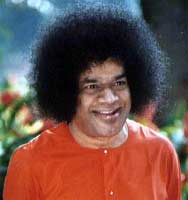 Peda Venkama Raju and mother Iswaramba. Earlier called Sathyanarayana Raju he later became Satya Sai Baba. The word 'Sathya' means truth, 'Sai' means mother and 'Baba' means father.
Peda Venkama Raju and mother Iswaramba. Earlier called Sathyanarayana Raju he later became Satya Sai Baba. The word 'Sathya' means truth, 'Sai' means mother and 'Baba' means father.
Even from a young age he was different from his fellow mates. He used to lead his school mates in devotional songs and be their 'guru'. In 1940, when Satya was 13, a change came over him. He went into a deep state of Samadhi (trance) and had to leave High School. He began to perform miracles like manifesting things out of thin air and show powers of tracing lost property, reading others thoughts and so on. So people began to have faith in him.
Soon afterwards, Satya Sai Baba announcing that he was reincarnation of the late holy man Shirdi Sai Baba, abandoned his family and set himself for what he believed in, the uplift of mankind - regardless of race, belief or background - without interruption or any kind of leisure. His followers grew in number and he established Prashanti Nilayam (abode of Eternal peace), an ashram where people could seek his guidance.
Satya Sai Babha now has more than 6000 spiritual service centres around the world dedicated to the study and practical application of the teachings of Sathya Sai Baba which strongly emphasizes on service to community. His charitable work include providing free education in the colleges he has established, providing free medical care in the super specialty hospital near his ashram and also in other hospitals and clinics. The members of the service centers are involved in feeding the hungry, visiting hospitals, working with needy children and caring for the aged. As an educator he has inspired the development of a humanistic and spiritual educational programme (Education in Human Values) which has been accepted as a curriculum in elementary schools in India.
MALLIKA SARABHAI-Kuchipudi & Bharatnatyam Dancer
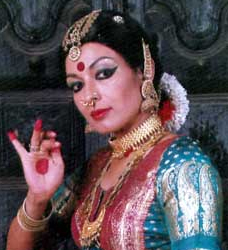
Mallika started her acting career when she was fifteen and starred in Gujarati and Hindi films. She has also played the role of Draupadi in Peter Brooke's film 'Mahabharata', which was made in English and French. After completing her graduation, Mallika entered into the world of performing arts. She followed the foot steps of her mother and places herself firmly at the cutting edge of Indian dance and dance theatre. Along with her other interests, she took her Masters in Business Administration from the Indian Institute of Management, Ahmedabad and a doctorate in organisational behaviour.
Mallika, along with her mother co-directs the Darpana Academy of Performing arts in Ahmedabad, a unique centre for the arts which has performed all over India and abroad. Today the academy has many faces; the Darpana Performance Group, the Janavak Folk and Tribal Dance Company, Darpana for Development, Darpana Communications, the Darpana Conservatoire etc .
Mallika received her first award in 1977. She was the recipient of the "French Palme D'or", the highest civilian award by the French Government and in Paris she was honoured as the 'Best Soloist Artist' among 400 dancers from 25 countries among other awards.
Personally she is a strong character with her own ideas and she feels that dance is a living language which you can interpret the way you think best. She has learned both the theory and practice of dance and her experiments include compositions like Draupadi, Shakti - The Power of Woman, Sita's Daughters, Itan Kahani, Aspiration, Ganga, Surya etc. Whatever field she is involved in, be it an activist, writer, instigator of community projects, anchorperson of magazines or TV channels, painting with her feet, Mallika is so full of energy that she excels in it.


